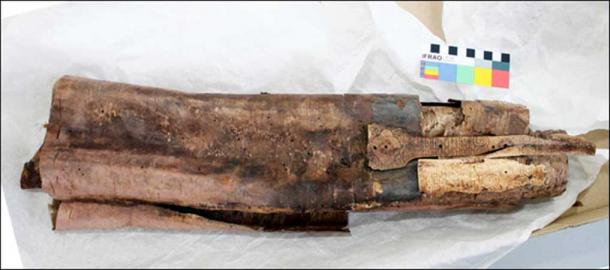
Burial Site of Siberian Archer with Intricate Arrows Unearthed in Altai Republic
By The Siberian Times Reporter
Medieval archer's 'unique quiver' and arrows with iron tips found in hole in a cliff, along with his wooden sarcophagus.
Two local residents accidentally stumbled across the burial site, close to the village of Kokorya, which contains the bones of an adult man, his birch bark quiver, arrow shafts and iron arrow heads, intricate ornaments and utensils made from the roots of trees, as well as the remnants of silk ribbons.
He is believed to be a warrior with a talent for archery who lived around the 13th to 15th century like the legendary outlaw Robin Hood in England.
The archer is likely to have been held in respect, confirmed by the location of his burial and the care taken to send him into the next life with his arrows and 'sophisticated' quiver. It has pockets for different types of arrows, say scientists.
Archeologists have not yet secured permission to open the wooden sarcophagus, although locals who found and looked inside confirm it contains bones, and it may also have the marksman's bow.

'Initially we thought that the bone plates were details of the bow, but they turned to be the decorations of the quiver.' Pictures: The Siberian Times, Vasily Oinoshev
Dr Nikita Konstantinov, Head of the Museum of Gorno-Altaisk State University, said: 'At the moment we have a birch bark quiver, two bone plates with elaborated ornaments, iron arrowheads, wooden arrow shafts, birch bark linings for a saddle, the remains of ribbons, likely silk, and what is left of a leather strap.
'Initially we thought that the bone plates were details of the bow, but they turned to be the decorations of the quiver.'
- Unravelling the Identity of the Real Robin Hood
- City of the Dead: The Mysterious Village of Dargavs, Russia
The warrior is suspected to be of Mongolian origin - 'there are no similar quivers found in our region, this is unique for Altai.' It was wrapped in silk ribbons when he was buried.
'The leather strap was used for attaching the quiver to the belt, we believe. Judging by the shape of the arrow heads, I would say that the owner was a warrior.' But they could also be used for hunting.


Judging by the shape of the arrow heads, I would say that the owner was a warrior.' Pictures: Nikita Konstantinov, Almadakov E.A.
Vasily Oinoshev, director of the Agency for Cultural and Historical Heritage of the Altai Republic, said: 'The quiver is a very interesting one. It has separate 'pockets' for different types of arrows.
'This quiver is a great find, it is very well preserved. It will be important to examine it more thoroughly to understand its construction.'
Archeologists hope to get permission to open and examine the sarcophagus next summer, and in the meantime, have taken steps to preserve the burial site. They hope to find the archer's bow and his saddle.
'Sadly we cannot go and excavate the grave immediately. We need to have a special permission for work,' said Dr. Oinoshev. 'Excavations are allowed in the period from 1 April 1 to 1 November. So as soon as we get all the permits we will go to work on this grave.

'There are no similar quivers found in our region, this is unique for Altai.' Picture: Almadakov E.A.
'We are doing all we can to ensure the safety of the grave in winter and to ensure the security of other archaeological objects. I have many questions to how these items were found.
'The story was that the locals found the grave in a hole in a cliff and took some items from there. But I am not completely sure they have not unearthed it. We need to check all this thoroughly.'
- 11,000 Years Old: New Dating of Shigir Idol reveals it is Oldest Wooden Sculpture in the World
- A day in the life of an ancient Russian hermit
Altai is a region where Mongolians sent their first external conquest in the 12th century. The area remained under Mongol sway until the 14th and 15th centuries.
According to Dr. Alexey Tishkin, an Altai researcher: 'When the Mongolian tribes came to Altai, previous Turk traditions were forgotten. Part of the local population was assimilated or destroyed.'
Finds from this Mongolian conquest are fairly rare in Altai. The wooden sarcophagus and cold dry climate helped the excellent preservation of the finds.
This article, originally titled ‘Burial site of Siberian Robin Hood unearthed in Altai Republic’, first appeared on Siberian Times and has been republished with permission.















